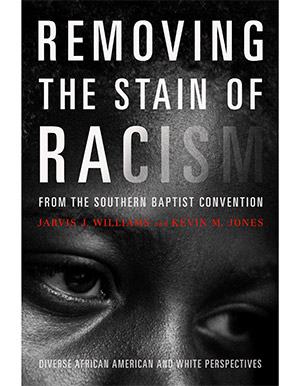Removing the Stain of Racism from the Southern Baptist Convention by Jarvis J. Williams and Kevin M. Jones, editors. (B&H Academic 2017, $24.99)
He had hardly left the church parking lot on the way to a missions and evangelism conference when an elderly and active lady in my father’s Southern Baptist congregation uttered the first of several racial slurs during our 30-minute trip. This was in 2006. I have spent my entire life in SBC congregations and the vast majority of racist remarks I recall hearing occurred on church property or during church activities. From my experience, the stain of racism in the Southern Baptist Convention isn’t merely a historical fact about our denomination’s pro-slavery roots but a shameful reality still living within the walls of many of our churches on Sunday morning.
The release of Removing the Stain of Racism from the Southern Baptist Convention, co-edited by Southern Seminary professor Jarvis J. Williams and Boyce College professor Kevin M. Jones, marks an encouraging sign in our denomination’s overdue progress. Consider the significance of the book being published by official SBC imprint B&H, whose former name “Broadman” honored SBTS co-founders and slaveholders John A. Broadus and Basil Manly Jr. Prompted by SBTS President R. Albert Mohler Jr.’s acknowledgment of “the stain of racism” in his spring 2015 convocation address, Williams and Jones gathered eight additional African-American leaders and three white SBC statesmen to offer insight on improving racial unity in the denomination — in areas ranging from preaching, leadership, education, and publishing.
“The Southern Baptist Convention has a big, dark, historical stain on it: racism,” Williams and Jones write in the preface. “The gospel of Jesus Christ requires and demands all Southern Baptists to do their parts to erase this stain from the SBC — or at least to make the stain less apparent. This act requires a relentless obedience to Christian unity.”
The opening contribution by Mohler reflects on how the SBC was “conceived in sin” because of its founders’ support of slavery and a heresy of racial superiority. “Diversity is not an accident or a problem; it is a sign of God’s providence and promise,” he writes. “If the church gets it wrong, it is not just getting race and ethnic difference wrong. It is getting the gospel wrong.”
Boyce College Dean Matthew J. Hall follows Mohler’s contribution by examining the historical causes of the stain of racism due to the racial hierarchy and hypocrisy of white Baptist leaders through the founding of America, the Civil War, and the Civil Rights movement. Hall contends today’s Baptists should “allow the ghosts of our racists forebears to haunt us” to be reminded of the abiding susceptibility to pride and hatred.
The heart of the book rests in Williams’ lengthy chapter on a biblical vision of racial unity in the SBC. A New Testament professor at SBTS, Williams surveys racial issues in the early church and analyzes how the Scripture offers a model for racial reconciliation, as the gospel has both vertical and horizontal implications.
The book also features stellar contributions from Kevin L. Smith on addressing racial unity from the pulpit, Mark A. Croston Sr. on the importance of denominational leadership to hire minorities, and Kevin M. Jones on improving Christian education to include more ethnically diverse reading and curriculum. Removing the Stain is an historic achievement, not merely for its presence and symbolism, but because applying its wisdom could alter the future of our denomination.





